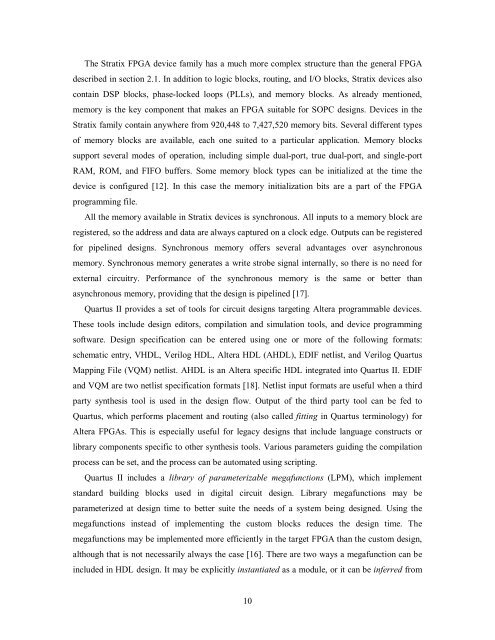Soft-Core Processor Design - CiteSeer
Soft-Core Processor Design - CiteSeer
Soft-Core Processor Design - CiteSeer
You also want an ePaper? Increase the reach of your titles
YUMPU automatically turns print PDFs into web optimized ePapers that Google loves.
The Stratix FPGA device family has a much more complex structure than the general FPGA<br />
described in section 2.1. In addition to logic blocks, routing, and I/O blocks, Stratix devices also<br />
contain DSP blocks, phase-locked loops (PLLs), and memory blocks. As already mentioned,<br />
memory is the key component that makes an FPGA suitable for SOPC designs. Devices in the<br />
Stratix family contain anywhere from 920,448 to 7,427,520 memory bits. Several different types<br />
of memory blocks are available, each one suited to a particular application. Memory blocks<br />
support several modes of operation, including simple dual-port, true dual-port, and single-port<br />
RAM, ROM, and FIFO buffers. Some memory block types can be initialized at the time the<br />
device is configured [12]. In this case the memory initialization bits are a part of the FPGA<br />
programming file.<br />
All the memory available in Stratix devices is synchronous. All inputs to a memory block are<br />
registered, so the address and data are always captured on a clock edge. Outputs can be registered<br />
for pipelined designs. Synchronous memory offers several advantages over asynchronous<br />
memory. Synchronous memory generates a write strobe signal internally, so there is no need for<br />
external circuitry. Performance of the synchronous memory is the same or better than<br />
asynchronous memory, providing that the design is pipelined [17].<br />
Quartus II provides a set of tools for circuit designs targeting Altera programmable devices.<br />
These tools include design editors, compilation and simulation tools, and device programming<br />
software. <strong>Design</strong> specification can be entered using one or more of the following formats:<br />
schematic entry, VHDL, Verilog HDL, Altera HDL (AHDL), EDIF netlist, and Verilog Quartus<br />
Mapping File (VQM) netlist. AHDL is an Altera specific HDL integrated into Quartus II. EDIF<br />
and VQM are two netlist specification formats [18]. Netlist input formats are useful when a third<br />
party synthesis tool is used in the design flow. Output of the third party tool can be fed to<br />
Quartus, which performs placement and routing (also called fitting in Quartus terminology) for<br />
Altera FPGAs. This is especially useful for legacy designs that include language constructs or<br />
library components specific to other synthesis tools. Various parameters guiding the compilation<br />
process can be set, and the process can be automated using scripting.<br />
Quartus II includes a library of parameterizable megafunctions (LPM), which implement<br />
standard building blocks used in digital circuit design. Library megafunctions may be<br />
parameterized at design time to better suite the needs of a system being designed. Using the<br />
megafunctions instead of implementing the custom blocks reduces the design time. The<br />
megafunctions may be implemented more efficiently in the target FPGA than the custom design,<br />
although that is not necessarily always the case [16]. There are two ways a megafunction can be<br />
included in HDL design. It may be explicitly instantiated as a module, or it can be inferred from<br />
10














